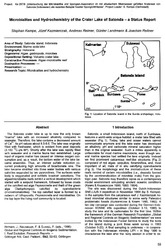Microbialites and hydrochemistry of the crater lake of Satonda
1996Geol. Inst. der Georg-august-Univ., Göttingen
Sammelband- / Konferenzbeitrag
Verlagsversion
Englisch
Kempe, Stephan; Kazmierczak, Józef; Reimer, Andreas; Landmann, Guenter; Reitner, Joachim, 1996: Microbialites and hydrochemistry of the crater lake of Satonda. In: Globale und regionale Steuerungsfaktoren biogener Sedimentation, DOI: 10.23689/fidgeo-2707.
 |
Dokument öffnen: |
The Satonda crater lake is up to now the only known
"marine" lake with an increased alkalinity compared to
seawater. Therefore, the lake contains a decreased amount
of Ca2
+. Its pH values about 8.5-8.6. The lake was originally
filled with freshwater, which is evident from peat deposits
(3,150 14C_yrs BP). Shortly after the lake was rapidly filled
with seawater and a marine fauna had established. Large
input of organic matter has caused an intense oxygen consumption
and, as a result, the bottom water of the lake became
anaerobic. Thus, an intense sulfate reduction occurred
producing high amounts of bicarbonate ions. The
lake became stratified into three water bodies with various
salinities separated by two pycnoclines. The surfaces water
body is oxygenated and exhibits brackish conditions. The
algae/microbialite reefs exhibit avertical development which
started with a serpulid framework, followed by loose crusts
of the calcified red alga Peyssonnelia and thalli of the green
alga Cladophoropsis calcified by cyanobacteria
(microstromatolites). The top calcified layer is formed by a
network of Lithoporella, Peyssonnelia and microbialites. On
the top layer the living reef community is located.
Statistik:
ZugriffsstatistikSammlung:
- Geologie [933]

